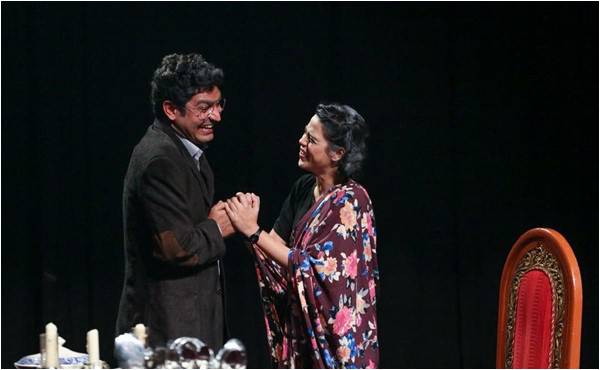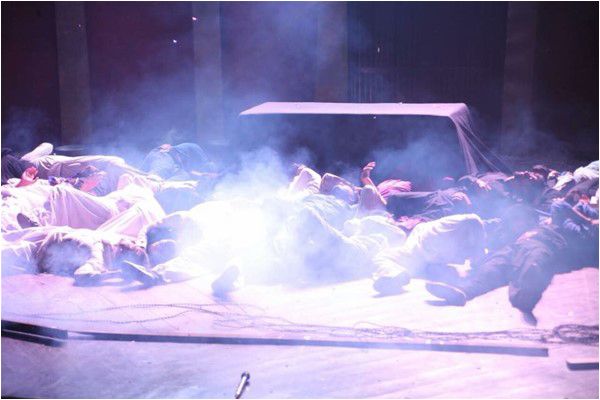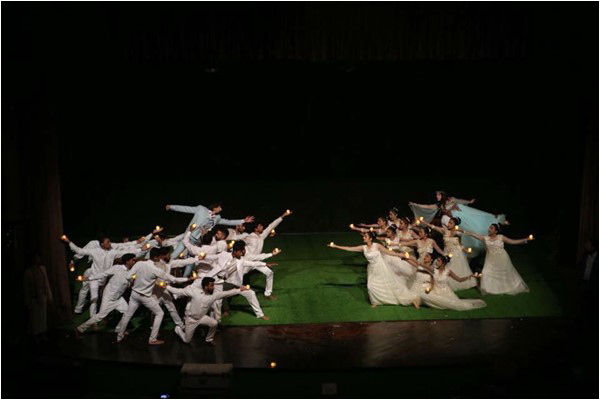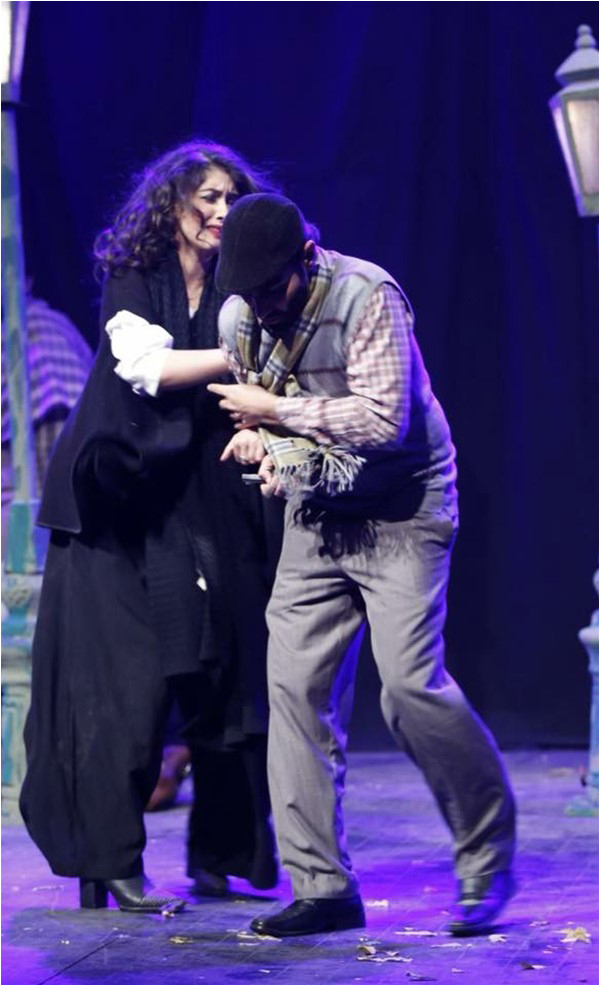
Hardly has a play that revolves around the Partition of 1947 and the divide between India and Pakistan amused, entertained and bewitched like the play Hua Kuch Yun did.
The play Hua Kuch Yun (So It Happened) was performed in Lahore’s Alhamra Arts Council this January.
Hua Kuch Yun, a play produced by the Kopy Kat Productions, written by Sajjid Hassan (yes, the famed actor from PTV), directed by Dawar Mehmood and produced by Aneeqa Khan is now being performed in Karachi and will reach Islamabad in mid-April. Dawar Mehmood has already presented successful theatre productions like Siachen, Angan Terha, 14 August and Banannistan, and has carved out a niche for himself in theatre. The script, according to the director Dawar Mahmood, took two years to write and Sajjid Hassan has still expressed his dissatisfaction with the final presentation.
The main protagonists Quratulain and Raja. Both are Indian Muslims in pre-Partition Amritsar and orphaned due to the Jallianwala Bagh massacre. From that point on the play oscillates between them meeting and separating. And meanwhile, some key historical events take place- like the evolution of the Pakistan Movement, Partition, Bhutto’s execution and Indira Gandhi’s assassination. At times it seems like a salad bar where historical events have been picked and stacked into the performance. The plot was imperfect and contrived indeed. At times it deviates too much and on other occasions, scenes become too lengthy.


However, the humour, one-liners, special effects, action and romantic scenes saved the day. The characters etched out in detail. Particularly Quratulain, played by Fareeha Raza, is vivacious, independent, brave and dedicated to the idea of an independent India. She is a debater and eventually a politician. Raja, played by Saad Farrukh Khan, is meek and more conventional in his life choices. Though he successfully argues with the heroine, overall, his presence is more subtle and at times even weaker than his female counterpart. This makes the equation all the more interesting and modern. Annie is complete with all her bravado, emotional logic and carried much of the funny one-liners with ease. Though, of course, she sounds way too forward-looking and confident than someone born around 1919 would be. Annie is a feminist icon who is misplaced in the pre-Partition context.
The breadth of the play, its sheer canvas and the scope of its themes is immense. There is grief, loss, separation, abandonment, commitment and a love that survives decades. There is a lot of glamour and wit. The heroine is young, thin and elegantly dressed.
The actors didn’t use the stage entrances alone. They used the entrances meant for the crowd and a lot of the action took place in the midst of the crowd. And this added to the surprise and drama. Those sitting at the back probably didn’t regret it later.
Everything is executed to perfection. The opening scene with the Jalianwalla Bagh massacre fired real firearms, sending a wave of terror through the crowd. This is repeated in other murder scenes too, but it is thankfully less loud.
The play has nearly 180 cast members, 35 actors and 11 set changes - the scale of this production is massive and therefore successfully stuns the ordinary viewer. The background scenes like the one at Aligarh University, a Catholic orphanage, the house of Khushwant Singh where the murders of Raja and Annie’s parents take place, Indira Gandhi’s dining room and the sequence in the pre-partition Indian market are all magnificent. However, had the duration of the play been shorter and some scenes removed from the plot - it would have made the play more plausible and effective. The scenes involving Indira Gandhi and Zulfikar Ali Bhutto were far-fetched. The play was probably better off without them.
The play was a modern and commercial one like those in the West are. It has all the qualities of a great musical, comedy and epic. The play’s production team is also concerned that classical plays by Kamal Ahmed Rizvi and Bano Qudsia did not receive the same hype and acclaim when they were recently presented at the Lahore Arts Council. Therefore, they gave the themes surrounding Partition a more flamboyant makeover to appeal to the younger audience.

And this did work successfully. The halls were almost full everywhere and the marketing team ensures that enough online hype is created.
Taha Humayun, who played Venkat the villain, remains the only constant in the cast, other than the hero and heroine. Everyone else comes and goes. He leaves an impact with his accent and comic timing. Khushwant Singh, the foster father of Annie was played by Adil Bangash and he gave a very nuanced performance with his authentic Punjabi accent and looks. The vendor in the market scene and the grotesque murderer of Khushwant Singh were also both powerful performers.
The play is worth the time and money if you enjoy comedy, action and drama. But those desiring a more philosophical voyage into the Subcontinent’s past, feel an eye-watering intense romance and sentimentality might be caught off guard.
An extravagant dance sequence follows at the end, which probably represents Raja and Annie dancing in Heaven. The sheer impact of the Westernised music, the dancers and choreography leave the audience dazed. South Asian cinema has prepared us enough for these musical intrusions in the plot. The whole play has a young cast and a youthful vibe to it. The viewer can feel the vitality and exuberance of their performance.
One major challenge to the new Pakistani theatre is that it has to compete with television, films and the entertainment on the internet which is easy to reach and breezy in nature. Therefore, perhaps the writers and directors thought that a less action-oriented, more reflective and deeper script that touches issues like identity, fragmentation, black humour or other negativity that comes up in Partition literature might sway the readers away from the play. This is probably why Hua Kuch Yun got such negative reviews. Most of the grim sentiments related to Partition are carefully avoided and only the violence is depicted. The viewer who wants a flavour of the angst, a Manto-like post-Partition existential dilemma and a sense of horror depicted by authors like Abdullah Hussain might feel discontented at the end.
However, this theatre play is among at least half a dozen productions that have been presented at the Lahore Arts Council and marks a recent trend of commercial productions that successfully pull and amuse crowds. This is a renaissance in Pakistan’s stage scene and probably the most fertile period since decades. One must appreciate this bout of successful theatre production houses and expect finer presentations from them.
The play Hua Kuch Yun (So It Happened) was performed in Lahore’s Alhamra Arts Council this January.
Hua Kuch Yun, a play produced by the Kopy Kat Productions, written by Sajjid Hassan (yes, the famed actor from PTV), directed by Dawar Mehmood and produced by Aneeqa Khan is now being performed in Karachi and will reach Islamabad in mid-April. Dawar Mehmood has already presented successful theatre productions like Siachen, Angan Terha, 14 August and Banannistan, and has carved out a niche for himself in theatre. The script, according to the director Dawar Mahmood, took two years to write and Sajjid Hassan has still expressed his dissatisfaction with the final presentation.
The main protagonists Quratulain and Raja. Both are Indian Muslims in pre-Partition Amritsar and orphaned due to the Jallianwala Bagh massacre. From that point on the play oscillates between them meeting and separating. And meanwhile, some key historical events take place- like the evolution of the Pakistan Movement, Partition, Bhutto’s execution and Indira Gandhi’s assassination. At times it seems like a salad bar where historical events have been picked and stacked into the performance. The plot was imperfect and contrived indeed. At times it deviates too much and on other occasions, scenes become too lengthy.


However, the humour, one-liners, special effects, action and romantic scenes saved the day. The characters etched out in detail. Particularly Quratulain, played by Fareeha Raza, is vivacious, independent, brave and dedicated to the idea of an independent India. She is a debater and eventually a politician. Raja, played by Saad Farrukh Khan, is meek and more conventional in his life choices. Though he successfully argues with the heroine, overall, his presence is more subtle and at times even weaker than his female counterpart. This makes the equation all the more interesting and modern. Annie is complete with all her bravado, emotional logic and carried much of the funny one-liners with ease. Though, of course, she sounds way too forward-looking and confident than someone born around 1919 would be. Annie is a feminist icon who is misplaced in the pre-Partition context.
The breadth of the play, its sheer canvas and the scope of its themes is immense. There is grief, loss, separation, abandonment, commitment and a love that survives decades. There is a lot of glamour and wit. The heroine is young, thin and elegantly dressed.
The actors didn’t use the stage entrances alone. They used the entrances meant for the crowd and a lot of the action took place in the midst of the crowd. And this added to the surprise and drama. Those sitting at the back probably didn’t regret it later.
This is a renaissance in Pakistan's stage scene and probably the most fertile period since decades
Everything is executed to perfection. The opening scene with the Jalianwalla Bagh massacre fired real firearms, sending a wave of terror through the crowd. This is repeated in other murder scenes too, but it is thankfully less loud.
The play has nearly 180 cast members, 35 actors and 11 set changes - the scale of this production is massive and therefore successfully stuns the ordinary viewer. The background scenes like the one at Aligarh University, a Catholic orphanage, the house of Khushwant Singh where the murders of Raja and Annie’s parents take place, Indira Gandhi’s dining room and the sequence in the pre-partition Indian market are all magnificent. However, had the duration of the play been shorter and some scenes removed from the plot - it would have made the play more plausible and effective. The scenes involving Indira Gandhi and Zulfikar Ali Bhutto were far-fetched. The play was probably better off without them.
The play was a modern and commercial one like those in the West are. It has all the qualities of a great musical, comedy and epic. The play’s production team is also concerned that classical plays by Kamal Ahmed Rizvi and Bano Qudsia did not receive the same hype and acclaim when they were recently presented at the Lahore Arts Council. Therefore, they gave the themes surrounding Partition a more flamboyant makeover to appeal to the younger audience.

And this did work successfully. The halls were almost full everywhere and the marketing team ensures that enough online hype is created.
Taha Humayun, who played Venkat the villain, remains the only constant in the cast, other than the hero and heroine. Everyone else comes and goes. He leaves an impact with his accent and comic timing. Khushwant Singh, the foster father of Annie was played by Adil Bangash and he gave a very nuanced performance with his authentic Punjabi accent and looks. The vendor in the market scene and the grotesque murderer of Khushwant Singh were also both powerful performers.
The play is worth the time and money if you enjoy comedy, action and drama. But those desiring a more philosophical voyage into the Subcontinent’s past, feel an eye-watering intense romance and sentimentality might be caught off guard.
An extravagant dance sequence follows at the end, which probably represents Raja and Annie dancing in Heaven. The sheer impact of the Westernised music, the dancers and choreography leave the audience dazed. South Asian cinema has prepared us enough for these musical intrusions in the plot. The whole play has a young cast and a youthful vibe to it. The viewer can feel the vitality and exuberance of their performance.
One major challenge to the new Pakistani theatre is that it has to compete with television, films and the entertainment on the internet which is easy to reach and breezy in nature. Therefore, perhaps the writers and directors thought that a less action-oriented, more reflective and deeper script that touches issues like identity, fragmentation, black humour or other negativity that comes up in Partition literature might sway the readers away from the play. This is probably why Hua Kuch Yun got such negative reviews. Most of the grim sentiments related to Partition are carefully avoided and only the violence is depicted. The viewer who wants a flavour of the angst, a Manto-like post-Partition existential dilemma and a sense of horror depicted by authors like Abdullah Hussain might feel discontented at the end.
However, this theatre play is among at least half a dozen productions that have been presented at the Lahore Arts Council and marks a recent trend of commercial productions that successfully pull and amuse crowds. This is a renaissance in Pakistan’s stage scene and probably the most fertile period since decades. One must appreciate this bout of successful theatre production houses and expect finer presentations from them.

